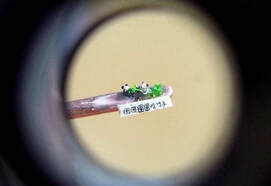“What? Are you telling me that you finally opened that business you always wanted?”
“Yep. Don’s Tea Room and Bait Shop.”
“What?”
“Got some nice round tea tables with a flower vase on each and those little curvy icecream parlor chairs with decorative wire backs.”
“But you said ‘bait shop.’ Did I not hear you correctly?”
“No, you heard me. Tea tables and chairs on on one side near the gingham-curtained windows. Got boxes of dirt with worms in them on the other side of the room away from the sunlight by the windows. You know, gotta keep the worms in the dark. That’s why that side of the room has black paint on the walls.”
“Where is this business?”
“I found a place to rent next to Ben’s Flowers and Ammo shop. He has a booming business. I figture I’ll get some of his customers.”
“Who’s going to sit for tea in a room with boxes of dirt and worms?”
“You’d be surprised. Besides, they aren’t right next to each other. There’s a separation. As I said, the tea tables are by the windows with the panes. Got fresh flowers in little pots on the window sills and flower boxes on the outside of the windows. I get the flowers from Ben next door. He gives me a deal on flowers that have a day or two left in them. Sometimes I find flowers along the road. You know what Chris Browne has his comic strip character Hagar the Horrible say, ‘Sometimes it pays to stop and steal the flowers.’ Anyway, got flowers on one side of the shop and bait and flies on the other side. You can’t imagine how many fishermen I lure in because of the tea. Must like the exotic flavors and the printed tea cups and saucers.”
“This has to be a joke, right?”
“No, come to the shop. Here. If I’m not there when you go, give this gift card to the girl behind the counter. It’s good for either tea or worms.”
“But where did such a crazy idea for a business come from?”
“Humanity.”
“Huh?”
“People. I mean, look around. Can’t you see the tea room side of individuals? And then there’s that bait shop side. People want others to know them by the side they choose, but every tea drinker has a box of worms somewhere. Both kinds take pride in their choice, in tea or worms, in the manners and fashion of one or the other. But some people are willing to let others see both their sides, like wearing hip boots with suspenders while sitting in an icecream chair sipping tea. Some people aren’t hung up on one or the other. Everyone has at least two sides, tea cups and fishing lures, tea and worms. Only the proud limit themselves. At Don’s Tea Room and Bait Shop I provide a venue for people to express their complexity.”
“Okay, you got me. I’ll be in next Saturday.”
“Should I tell the girl to reserve you a chair or a bag of worms?”
“Well, you have me thinking. Tell her to reserve one of each.”


 RSS Feed
RSS Feed